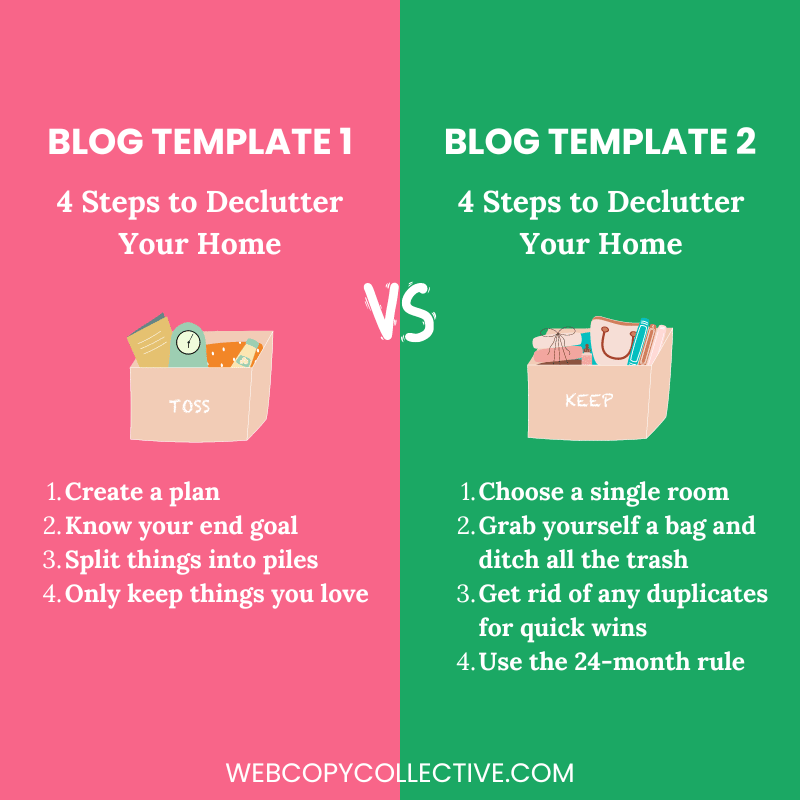How to Craft Website Copy That Converts
You don’t need to be a professional copywriter to write website copy that converts. In fact, writing great copy doesn’t take secret hacks, expensive tools, or hiring a professional.
Here are the no-BS tips I give to my clients when they want to improve their website copy.
Implement these strategies to easily improve your website content and get your visitors hooked on your messaging.
How to Write Drool-Worthy Website Copy
1. Write for One, Not All
One of the first challenges many of my clients face is the idea of creating website content for thousands of visitors.
It’s overwhelming to think about writing website copy that appeals to all those people and connects with a large enough audience to convert into sales.
But you’re not writing for an audience of thousands.
You’re writing for one person – your ideal client.
Imagine the perfect client you’d love to work with. Someone who would instantly want your services, resonate with your brand, and easily be a cheerleader for your business.
Give them a name, a job, likes and dislikes, and flesh them out until they’re a real person in your mind.
That’s the only person you’re creating content for.
When you write website copy, imagine you’re talking to them face-to-face and sharing your insights with just them. Think about what questions they’d have and how they would respond to your writing, and tailor your content to help them.
Having that ideal client in mind takes the pressure off of content creation. All you have to do is give value to that one person, and you’ll start seeing results.
With that in mind, avoid phrases like:
Hey guys!
Have any of you ever…
Everyone reading this blog should...
Remember, you’re not creating content for a giant audience. You’re just writing for that one perfect client.
2. Create Baby Paragraphs
Break your copy up into 1-2 short-sentence paragraphs. Around 43% of low-performing content has too many long sentences.
It goes against everything you learned in school, and it will look ridiculous in a Google document, but it’s worth it.
When readers land on your blog, they’re not reading every single word. Instead, they’re scanning down the page, picking out sentences, titles, and the most emphasised copy.
If you’ve got any long paragraphs, they’re getting ignored. And when I say long, I mean any more than 90 words.
Since over 60% of people visit your site from their mobile devices, even baby paragraphs look long on the smaller screens.
So, use your phone to search for your website and see if your website copywriting is scannable.
Does your website copy have plenty of short sentences with breathing space, or do you have large chunks of copy? Split it up to make it instantly more binge-worthy.
Related: Unconventional Blogging Tips That Exploded My Blog
3. You/Your > I/My
There’s a delicate balancing act between showcasing your expertise and tailoring your content to your ideal client.
People want to read anecdotes, real-life stories, and your experiences. But they also want to feel like your content is there to help them, not sell your product.
Take a look at your service page, blog, or homepage. Are you using “I” and “My” more than “You” and “Your”?
The first one is focused on the business owner. The second conveys the exact same message, but the focus shifts to the client.
Do a content review and make sure most of your content is focused on your client by shifting the perspective.
“My service” becomes “Your solution”
“I can help” becomes “You’ll receive”
“I offer X service” becomes “The perfect service for you”
4. Get Ultra-Specific
The most binge-worthy website copy gives actionable, ultra-specific information that readers can act on.
The internet is oversaturated with generic guides that offer no real-world value. The most successful blogs know that to stand out, you have to drill down into details.
Let’s say you’re writing a blog about how to declutter your house. Which of these structures looks more interesting:
The first template is generic and lacks action steps. There’s nothing there that’s making the reader feel the need to get up and get started.
The second template has actions involved. They’re more interesting and specific and give the reader a genuine course of action to follow.
Whenever you’re writing website copy, ask yourself, “Is this specific enough to be interesting, or am I being too generic?”
Particularly for blog writing, don’t be afraid to get down into the nitty gritty to give your readers real solutions.
Related: 26+ High-Converting Blog Title Ideas for Your Business
5. Add Real-life Examples
The best way to learn anything is from someone who’s already done it successfully. So, whether you’re writing a new service page, blog post, or landing page, you better come with receipts.
Sprinkle in short stories about your experiences that illustrate the point you’re trying to make or case studies that show real results.
Whenever I conduct a website copy audit for a client, this is one of the main things I like to focus on.
Your experience is what makes you unique, and sharing it is an easy way to make your website copywriting infinitely more binge-worthy.
Don’t fall into the trap of thinking your lived experiences aren’t exciting or interesting enough to share.
People love peaking behind the scenes and hearing more about the humans behind the brand.
Whether it’s about how you landed a 5-figure client or the lessons you learned from adopting a rescue puppy – it’s all shareable content that breathes life into your copy.
6. Remove Wet Flannel Language
Weak language will quickly make visitors lose confidence in your website, but it sneakily creeps into our copy without us realising it.
So, what do I mean by wet flannel language?
When you lack conviction in what you’re writing, you’ll start using fillers, clauses, and ‘weak’ language. Here’s an example:
“I believe that you could see results within a few months if you invest in my service.”
vs.
“When you invest in X service, you’ll see results in as little as 60 days.”
See how much stronger and more compelling the second one is?
But how do you spot weak language creeping into your copy? Here are some words and phrases to search for:
Fillers: basically, literally, kind of, like…
Hedges: I think, in my opinion, the way I see it…
Qualifiers: very, usually, enough, almost, most…
Tags: don’t you think? …right? Do you see what I’m saying?
The stronger your website copy, the more compelling it is, and the more your visitors will want to binge it.
7. Remove the Fluff
When I was a non-fiction book editor, 90% of my job was cutting fluff from manuscripts. Someone would submit a 50K-word book, and I’d give it back with just 30K words left.
Fluff is all the unnecessary website copy that makes your point fuzzy. It’s the tangents, extra information, filler words, and over-explanations.
We use fluff in conversation because we’ve got so much extra time to communicate. But you don’t have that luxury on your website.
Your readers want concise answers to their questions. Too much extra fluff, and you’ll lose their attention.
But it’s tough spotting fluff in your own writing – that’s why editors exist!
During website audits, I highlight all the fluff and show my clients how to communicate their points more effectively.
If you want to DIY it, read through one of your blogs pretending you’re a stranger who has just found this website.
Does it get to the point and give concise value? Or could you cut out chunks without losing any real coherency?
The more you write and edit your website copywriting, the better you’ll get at avoiding fluffy writing.
Related: 10+ Benefits of Blogging as a Service Provider
8. Don’t “Inject” Personality
I’ve always found it strange that content strategists tell you to “inject personality into your copy”.
Imagine trying to “inject” personality into conversations with people. You’d end up sounding like a caricature of yourself.
You already have a unique personality, whether it’s bubbly and funny, dry and witty, or serious and to the point.
You don’t need to force personality into your copy. Instead, give yourself the freedom to write and allow your unique personality to shine through naturally.
If you’re naturally funny, it will come through in your website copywriting. If you’re naturally more serious, that’s what your website copy will be. You don’t need to inject it in like a shot at the doctor’s office.
The worst thing you can do is try to force a personality you don’t naturally have. People binge authentic content, so be true to who you are.
Not everyone will resonate with your style of content, but you’ll quickly find the loyal tribe that loves your personality and how it shines in your copy.
9. Stop Stressing About Grammar
Oof, the editor in me is screaming at this one.
You don’t need flawless grammar to make your website copy binge-worthy. In fact, it’s better if you throw the grammar rule book out the window.
Short sentences, short paragraphs, and simplified wording do best on websites.
Even if your Grammarly app is telling you off for not including semi-colons or follow-on sentences, go with your gut and stick to a simplified structure.
Warning: Don’t use this tip as an excuse to ignore typos.
Spelling errors and typos are a huge red flag that your content isn’t professional. About 70% of website visitors are less likely to click on an ad if there are spelling or grammar errors. Google actually charges more for ads that have typos.
So, you should still use Grammarly to proofread and tidy up your sentence structure.
Related: Is Grammarly Premium Worth the Price Tag? [Expert Review]
10. Create a Clean, Decluttered Layout
The final step toward writing binge-worthy website copy is creating a clean, clutter-free layout with space to breathe:
Make sure your font is at least 16px to make it clear and legible on mobile screens.
Use a white background and black or very dark font to improve contrast.
Avoid too many pop-ups and ads that detract from the reading experience.
Use a well-known, clear font that’s easy to read.
Always left-align your text (unless it’s titles) – centred text is harder to read.
Use subheadings and bullet point lists to break up the text and introduce breathing space.
If you’re struggling with this step, a website audit is going to be a lifesaver. Check out what’s included in a tailored website copy audit here.
Still Struggling to Write Website Copy?
There’s no shortcut for writing website copy that’s binge-worthy. Your first few blogs will suck, your first draft service page won’t convert, and you’ll want to give up.
But the more you write, the better you get. You’ll develop a unique writing style as you go, and eventually, copywriting will be second nature.
Of course, even the experts need some help, so here are my must-have copywriting tools to make creating blogs insanely easier.



































![Is Grammarly Premium Worth it? [Review]](https://images.squarespace-cdn.com/content/v1/5910c2bec534a5947d4d3130/1739293407789-O7U2NFYVOR0DR6H06Y3N/Delicate+Feminine+Interior+Designer+Featured+Products+Facebook+Post+%2826%29.png)



